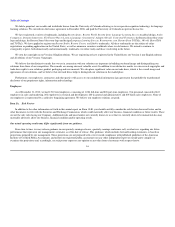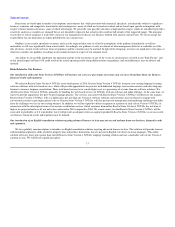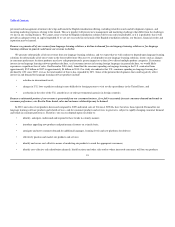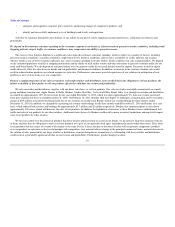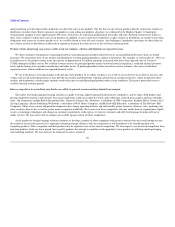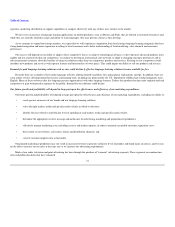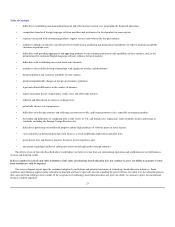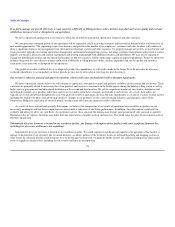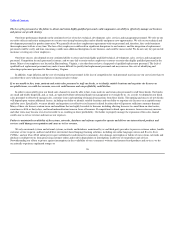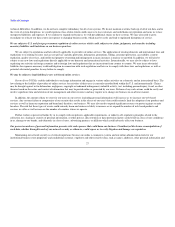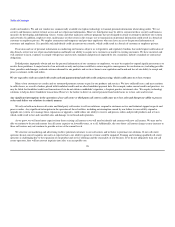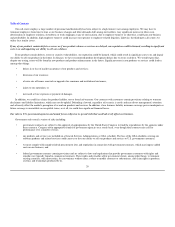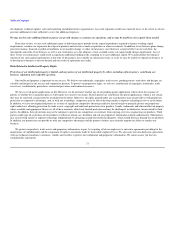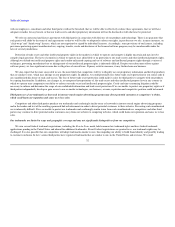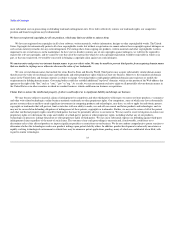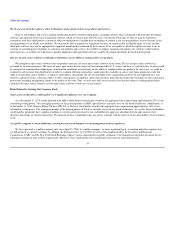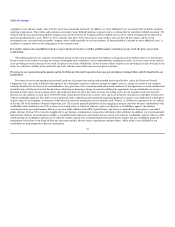Rosetta Stone 2010 Annual Report Download - page 27
Download and view the complete annual report
Please find page 27 of the 2010 Rosetta Stone annual report below. You can navigate through the pages in the report by either clicking on the pages listed below, or by using the keyword search tool below to find specific information within the annual report.
Table of Contents
If we fail to manage our growth effectively, we may experience difficulty in filling purchase orders, declines in product and service quality and customer
satisfaction, increased costs or disruption in our operations.
We have experienced rapid growth in our business, which has strained our managerial, operational, financial and other resources.
We anticipate that continued growth of our operations will be required to satisfy increasing consumer and institutional demand and to avail ourselves of
new market opportunities. The expanding scope of our business and growth in the number of our employees, customers and sales locations will continue to
place a significant strain on our management team, information technology systems and other resources. To properly manage our growth, we need to hire and
retain personnel, upgrade our existing operational, management and financial and reporting systems, including warehouse management and inventory control,
improve our business processes and controls and identify and develop relationships with additional retailers and distributors. We may also be required to
expand our distribution facilities and our operational facilities or add new facilities, which could require significant capital expenditures. Failure to effectively
manage our growth in a cost-effective manner could result in difficulty in filling purchase orders, declines in product and service quality and customer
satisfaction, increased costs or disruption of our operations.
Our growth also makes it difficult for us to adequately predict the expenditures we will need to make in the future. If we do not make the necessary
overhead expenditures to accommodate our future growth, we may not be successful in executing our growth strategy.
Our revenue is subject to seasonal and quarterly variations, which could cause our financial results to fluctuate significantly.
We have experienced, and we believe we will continue to experience, substantial seasonal and quarterly variations in our revenue and net income. These
variations are primarily related to increased sales of our products and services to consumers in the fourth quarter during the holiday selling season as well as
higher sales to governmental and educational institutions in the second and third quarters. We sell to a significant number of our retailers, distributors and
institutional customers on a purchase order basis and we receive orders when these customers need products and services. As a result, their orders are
typically not evenly distributed throughout the year. Our quarterly results of operations also may fluctuate significantly as a result of a variety of other factors,
including the timing of holidays and advertising initiatives, changes in our products, services and advertising initiatives and changes in those of our
competitors. Budgetary constraints of our institutional customers may also cause our quarterly results to fluctuate.
As a result of these seasonal and quarterly fluctuations, we believe that comparisons of our results of operations between different quarters are not
necessarily meaningful and that these comparisons are not reliable as indicators of our future performance. In addition, these fluctuations could result in
volatility and adversely affect our cash flows. As our business grows, these seasonal fluctuations may become more pronounced. Any seasonal or quarterly
fluctuations that we report in the future may differ from the expectations of market analysts and investors. This could cause the price of our common stock to
fluctuate significantly.
Substantially all of our inventory is located in one warehouse facility. Any damage or disruption at this facility could cause significant financial loss,
including loss of revenue and harm to our reputation.
Substantially all of our inventory is located in one warehouse facility. We could experience significant interruption in the operation of this facility or
damage or destruction of our inventory due to natural disasters, accidents, failures of the inventory locator or automated packing and shipping systems or
other events. If a material portion of our inventory were to be damaged or destroyed, we might be unable to meet our contractual obligations which could
cause us significant financial loss, including loss of revenue and harm to our reputation.
25



